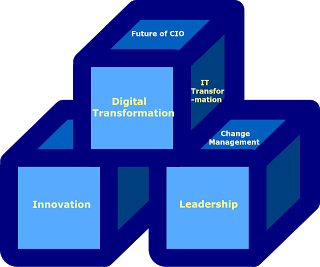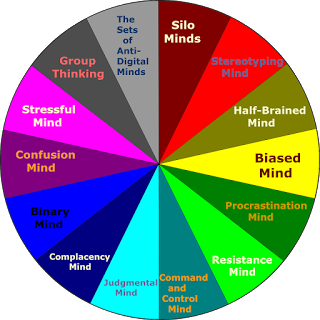Pearl Zhu's Blog, page 1254
February 2, 2017
The Weekly Insight of the “Future of CIO” 2/3/ 2017
 The “Future of CIO” Blog has reached 1.7 million page views with 3500+ blog posting in 59+ different categories of leadership, management, strategy, digitalization, change/talent, etc. The content richness is not for its own sake, but to convey the vision and share the wisdom. Here is the weekly insight about digital leadership, IT Management, and Talent Management. The Weekly Insight of the “Future of CIO” 2/3/2017CIOs as Chief Intrapreneur Officer: How to Encourage Creativity and Manage Innovation: It's common that many IT companies tend to focus more on their core competencies with age and often forget about the value of innovation. Without encouraging creativity, organizations would be upstaged by the ones that are creative because disruptive innovation will happen no matter how well you prepare. Digital IT needs to be run as a business, and digital CIOs should be the “Chief Intrapreneur Officer,” with “whole brain” thinking: Being logic in your mind based on your years of engineering training and experiences and be creative in your heart, dream big and think big. Because the CIO’s vision will directly impact their organization’s strategic perspective for the long term. So, how to encourage creativity and manage innovation effectively?
The “Future of CIO” Blog has reached 1.7 million page views with 3500+ blog posting in 59+ different categories of leadership, management, strategy, digitalization, change/talent, etc. The content richness is not for its own sake, but to convey the vision and share the wisdom. Here is the weekly insight about digital leadership, IT Management, and Talent Management. The Weekly Insight of the “Future of CIO” 2/3/2017CIOs as Chief Intrapreneur Officer: How to Encourage Creativity and Manage Innovation: It's common that many IT companies tend to focus more on their core competencies with age and often forget about the value of innovation. Without encouraging creativity, organizations would be upstaged by the ones that are creative because disruptive innovation will happen no matter how well you prepare. Digital IT needs to be run as a business, and digital CIOs should be the “Chief Intrapreneur Officer,” with “whole brain” thinking: Being logic in your mind based on your years of engineering training and experiences and be creative in your heart, dream big and think big. Because the CIO’s vision will directly impact their organization’s strategic perspective for the long term. So, how to encourage creativity and manage innovation effectively?
The New Book “Decision Master” Conclusion: Five Pillars in Achieving Decision Excellence: Decision-making is both science and art. Decision making is the art only when decision makers understand the science. Decision power is mind power. From the scientific perspective, decision-making is not an event, but a capability underpinned by a series of interrelated processes or steps. And there are five pillars in achieving decision-making maturity.
The Best-in-Class Digital Board: Corporate board as the top leadership team plays a significant role in business advising, leadership exemplarity, policy setting, and governance practices. How to build a best-in-class digital board? Is there any way for shareholders and key stakeholders to evaluate board leadership effectiveness?. Refresh CIO Leadership to Accelerate Digital Transformation The CIO role is considerably a newer top executive role compared to other business executive positions. At the static industrial age, IT was perceived as a cost center, and CIOs were labeled as the technical geek and tactical manager, and the majority of IT organizations get stuck in the lower level of maturity. However, due to the exponential growth of information and increasing speed of changes, technologies are often the disruptive force behind digital technologies. IT plays a more significant role in leading businesses forward at the front. So, how to refresh CIO leadership to accelerate digital transformation?
 The Monthly “Thinkingaire” Book Tuning: Avoid Those Anti-Digital Mindset Pitfalls Jan. 2017 With the increasing speed of change in the hyper-connected digital ecosystem, some industrial mindsets with “status quo” types of thinking, authoritarian attitude, and bureaucratic decision-make, are outdated, turn to be a "dragger" of the business innovation and a laggard of the digital paradigm shift. More specifically, what are those anti-digital mindsets, and how to shift them to digital thinking styles??
The Monthly “Thinkingaire” Book Tuning: Avoid Those Anti-Digital Mindset Pitfalls Jan. 2017 With the increasing speed of change in the hyper-connected digital ecosystem, some industrial mindsets with “status quo” types of thinking, authoritarian attitude, and bureaucratic decision-make, are outdated, turn to be a "dragger" of the business innovation and a laggard of the digital paradigm shift. More specifically, what are those anti-digital mindsets, and how to shift them to digital thinking styles??
Blogging is not about writing, but about thinking and innovating the new ideas; it’s not just about WHAT to say, but about WHY to say, and HOW to say it. It reflects the color and shade of your thought patterns, and it indicates the peaks and curves of your thinking waves. Unlike pure entertainment, quality and professional content takes time for digesting, contemplation and engaging, and therefore, it takes the time to attract the "hungry minds" and the "deep souls." It’s the journey to amplify diverse voices and deepen digital footprints, and it's the way to harness your innovative spirit.
Follow us at: @Pearl_Zhu
Published on February 02, 2017 22:24
The New Book “Decision Master” Thoughts and Quotes Collection II
 Decision Masters refer to the digital leaders or professionals who can leverage multidimensional thought processes, information and intuition, take a step-wise scenario for making effective decisions consistently. Decision Masters also refer to the businesses or organizations that follow a set of well-defined principles, leverage fine-tuned decision processes, efficient information management system, decision frameworks, tools, and metrics to enable people across the organization making effective decisions collaboratively.
Decision Masters refer to the digital leaders or professionals who can leverage multidimensional thought processes, information and intuition, take a step-wise scenario for making effective decisions consistently. Decision Masters also refer to the businesses or organizations that follow a set of well-defined principles, leverage fine-tuned decision processes, efficient information management system, decision frameworks, tools, and metrics to enable people across the organization making effective decisions collaboratively.
“Decision Master” is the guidebook to perceive digital mindsets with multidimensional decision intelligence, define a set of decision-making principles, articulate potential pitfalls in decision-making scenario, describe digital decision-making styles, summarize the important elements in building the decision-making capability and taking stepwise steps to achieve decision maturity.
29 Decisions always refer to the future and future is always uncertain.30 Decision-making style reflects leadership effectiveness and the level of digital professional maturity.31 People with different personalities approach decision making in a different way.32 Decision is about future; a decisive mind is future-driven.33 Information and decision-making are intimately connected and interdependent.34 Decisions are based on information and generate information.35 Information and decision-making are intimately connected and interdependent.36 Information applies to the context and environment in which decisions are made.37 A valuable intuition is an insight with the speed of thought.38 The key to decision-making is about the balance of intuition and logic; thinking fast and slow with harmony.39 Intuition is like the inner compass that gives direction to the business leaders or professionals in making the decisions.40 The hybrid decision-making style is practical because we live in such a hybrid, networked and extended modern digital working environment. 41 Decision-making is the discipline across the art and science; gut feeling and information; confidence and humility.42 Poor decision making is often caused by reactive styles; ineffective processes, lack of knowledge or resources, cognitive gaps, unconscious biases, or procrastination, etc. 43 The characteristic of participative decision-making is to embrace the collective insight for achieving decision-making effectiveness and maturity.
 44 Communicating to others raises the total cognitive threshold to fill decision-making blind spots.45 Decision power is mind power.46 “What is the decision” must sit between thought and action.47 Effective decision making in the digital era requires speed, flexibility, and collective wisdom.48 Business managers and professionals also have to live with the consequences of making the wrong decisions faster.
44 Communicating to others raises the total cognitive threshold to fill decision-making blind spots.45 Decision power is mind power.46 “What is the decision” must sit between thought and action.47 Effective decision making in the digital era requires speed, flexibility, and collective wisdom.48 Business managers and professionals also have to live with the consequences of making the wrong decisions faster.Follow us at: @Pearl_Zhu
Published on February 02, 2017 22:21
How does IT handle investigations of innovative business solutions?
 IT plays a critical role in building business competency. IT has itself transformed to creating a new competitive advantage via building new products, new services and delivering tailored business solutions. But many of today’s C-suites are unaware of what is technologically possible now or in the future. Digital is the age of options, it provides the opportunity to think the new way to do things, so it forces IT leaders to get really creative on how they architect and implement change, and how IT handles investigation of innovative business solutions, to change the business’s perception, reinvent its tarnished reputation and improve its maturity.
IT plays a critical role in building business competency. IT has itself transformed to creating a new competitive advantage via building new products, new services and delivering tailored business solutions. But many of today’s C-suites are unaware of what is technologically possible now or in the future. Digital is the age of options, it provides the opportunity to think the new way to do things, so it forces IT leaders to get really creative on how they architect and implement change, and how IT handles investigation of innovative business solutions, to change the business’s perception, reinvent its tarnished reputation and improve its maturity.
CIOs need to be creative enough to think out-of-the-box and embrace great ideas; and logical enough to plan, engineer and follow through: Though that most of IT Operations involve analytical and logical work, some argue it is the creative mind better suited for top leadership, and CIO as “Chief Innovation Officer” is one of the most appropriate titles for today’s digital IT leaders. It is imperative to have the CIO think of new and uncommon ways how IT can contribute to the corporation and help the business to make right strategy with a growth mindset. Businesses are looking for IT to add new innovative methods for management of complexity, develop the next practice for business transformation, investigate innovative business solutions, improving quality, or optimizing business capabilities, etc., to ensuring IT is strategically positioned to be ahead of where the business is moving next. Any leadership role, especially a CIO, needs to be better-rounded than to have a title of "logical" or "creative." They should be good at both. A logical mind can follow directions and take a step-wise approach, but a creative mind can make a difference. A CIO has to be logical enough to plan, engineer and follow through, but more importantly. A CIO needs to be creative and persuasive in order to get their ideas approved and funded.
Encourage IT talent to gain business acumen and encourage them to see the old problems from every direction and find alternative solutions: Innovation is not always equal to the latest gadget, it’s about people, culture, process, partnership, manners, etc. Hence, IT has to take a holistic approach to handling investigation of innovative business solutions, not for fixing symptoms, but to cure the root cause and create business differentiation. To break the mold, IT needs to rethink itself as an innovative hub of the business composed not only of technical ‘gurus,’ but rather of business ‘gurus’ who also happen to be technically proficient, so they can understand the real world business problems deeply and investigate innovative business solutions from the customer’s lenses, not from IT perspective. Many legacy businesses come with a legacy mindset, the old way to do the things, lack the important elements to spark innovation: vision, passion, and progression. So, it’s important to educate IT team on the business and encourage them to engage with business counterparts in a value-oriented manner, ask tough questions, channel the energy, enthusiasm, and ideas, to not only come out one solution to the old or new business problem, but multiple solutions and manage innovation in a structural way.
 IT should also handle investigations of innovative business solutions via evaluating and recognizing their innovative vendors and partners: Businesses are looking for innovation capability from their IT service providers. The innovation capabilities IT vendors can provide to their clients are to connect the dots via borrowing the fresh idea from totally different industry or geographical boundaries. IT vendors work with their clients across industries, across territories, accumulate many success stories or failure anecdotes to benefit their client, for adopting the best solutions and avoiding pitfalls. The superior IT vendors provide tailored and innovative solutions to not only fix the specific problems but also optimizing the underlying functions or processes that the client side depends on for competitive advantage. They are expecting for vendors to figure out ways to perform the IT lifecycle, whether they are doing hardware or software or a combined integration, with less drain on their organization, they also expect vendors to deliver flexible, innovative and high-quality customer-tailored solutions. Their expertise is not only technical specialty, more importantly, they can also deliver the outside box thinking and expansive talent pool, culture wisdom and process innovation.
IT should also handle investigations of innovative business solutions via evaluating and recognizing their innovative vendors and partners: Businesses are looking for innovation capability from their IT service providers. The innovation capabilities IT vendors can provide to their clients are to connect the dots via borrowing the fresh idea from totally different industry or geographical boundaries. IT vendors work with their clients across industries, across territories, accumulate many success stories or failure anecdotes to benefit their client, for adopting the best solutions and avoiding pitfalls. The superior IT vendors provide tailored and innovative solutions to not only fix the specific problems but also optimizing the underlying functions or processes that the client side depends on for competitive advantage. They are expecting for vendors to figure out ways to perform the IT lifecycle, whether they are doing hardware or software or a combined integration, with less drain on their organization, they also expect vendors to deliver flexible, innovative and high-quality customer-tailored solutions. Their expertise is not only technical specialty, more importantly, they can also deliver the outside box thinking and expansive talent pool, culture wisdom and process innovation.
Hence, today’s IT leaders also need to be “Chief Investigation Officer” to truly understand business problems via different angles, see around the corner and underneath the surface. Regardless of which industry or organization you are in, being an innovative leader will need to master the art of creating unique, differentiating business solutions from piles of commoditized technologies and take advantage of the emergent digital trend as well, with the ultimate goals run, grow and transform the business, maximize business potential and achieve high-performance business results.
Follow us at: @Pearl_Zhu
Published on February 02, 2017 22:18
February 1, 2017
The Monthly “CIO Master” Book Tuning: IT Performance Management Jan. 2017
 Corporate Performance Management is a management control from strategy till shop floor. "If you can't measure, you can't manage," legendary management guru Peter Drucker once asserted. He was right Managing performance means understanding results, setting metrics, fixing plans, and making decisions to ensure it happens. It takes multifaceted approaches from multidimensional perspectives.
Corporate Performance Management is a management control from strategy till shop floor. "If you can't measure, you can't manage," legendary management guru Peter Drucker once asserted. He was right Managing performance means understanding results, setting metrics, fixing plans, and making decisions to ensure it happens. It takes multifaceted approaches from multidimensional perspectives.IT Performance Management
Making IT Assessment for Leading Digital Transformation? Due to increasing speed of changes and exponential growth of information, more often than not, technology is the driver of business changes or the accelerator of the digital transformation. How can IT shift from a back office support function to the digital brain yard and forerunner? How should IT leaders and managers make an objective and comprehensive IT management assessment in order to lead changes and digital transformation effortlessly?
IT Performance Measurement Pitfalls Today’s IT organization intends to become the business’s growth engine, rather than just a maintenance back-office, the problem is that the IT folks tend to see IT value in things that aren't as important to the business. Performance Indicators for IT need to be defined in keeping the view of the corporate objectives and put into a mix of other performance measures. Poor defined IT performance measurement will mislead strategy management. More specifically, what are IT performance measurement pitfalls, and how to avoid them?
The Noble Purposes of IT Performance Management? IT organizations are at the crossroad to either ride above the learning curve of the digital transformation or become irrelevant as a support function. IT metrics has to evolve from being a cost center to becoming a revenue generator. It’s dangerous to impose metrics just because the focus on what’s measurable is manageable. The only way to do this is to show a clear link to top executives between IT efficiency and productivity and top-line revenues. Continually accelerating changes in IT consumption and production requires faster responses and better performance metrics. Start with the noble purposes of IT performance management and then select the right set of metrics for measuring the right things and measure them right. IT measures should cover all areas that contribute to value creation including service quality, employee engagement, customer satisfaction and financial outcomes itself.?
A set of Q&As (VIII) for IT Performance Management Modern CIOs face many challenges, it is not sufficient to only keep the lights on. Regardless of which industry or the nature of organization you are in, being a digital leader will need to master the art of creating unique, differentiating value from piles of commoditized technologies and take advantage of the emergent digital trend as well; digital CIOs also have multiple personas, “Chief Innovation Officer,” “Chief Insight Officer,” “Chief Improvement Officer,” “Chief Information Officer,” and here, we discuss CIOs as “Chief Inquisitive Officer,” with a set of Q&As to lead digital transformation.
 Three Performance Indicators for Keeping IT and the Business at the Same Page: Forward-looking IT organizations are on the journey of digital transformation. To improve IT management effectiveness and efficiency, keep in mind of this management mantra -”You can only manage what you measure.”CIOs need to keep a measure and periodicity at which the measure is reviewed against setting targets. Then ensure IT raises the bar on a continual basis to ensure the stakeholders get a real picture of how well the IT efforts are bearing desired results and keep IT and the business on the same page via the following indicators for accelerating digital transformation.
Three Performance Indicators for Keeping IT and the Business at the Same Page: Forward-looking IT organizations are on the journey of digital transformation. To improve IT management effectiveness and efficiency, keep in mind of this management mantra -”You can only manage what you measure.”CIOs need to keep a measure and periodicity at which the measure is reviewed against setting targets. Then ensure IT raises the bar on a continual basis to ensure the stakeholders get a real picture of how well the IT efforts are bearing desired results and keep IT and the business on the same page via the following indicators for accelerating digital transformation.
The blog is a dynamic book flowing with your thought; growing through your dedication; sharing your knowledge; conveying your wisdom, and making influence through touching the hearts and connecting the minds across the globe. The “Future of CIO” Blog has reached 1.7 million page views with about #3500 blog posting. Among 59+ different categories of leadership, management, strategy, digitalization, change/talent, etc. Blogging is not about writing, but about thinking and innovating the new ideas; it’s not just about WHAT to say, but about WHY to say, and HOW to say it. It reflects the color and shade of your thought patterns, and it indicates the peaks and curves of your thinking waves. Unlike pure entertainment, quality and professional content takes time for digesting, contemplation and engaging, and therefore, it takes the time to attract the "hungry minds" and the "deep souls." It’s the journey to amplify diverse voices and deepen digital footprints, and it's the way to harness your innovative spirit.
Follow us at: @Pearl_Zhu
Published on February 01, 2017 22:20
The New Book “Decision Master” Quote Collection I
 Decision Masters refer to the digital leaders or professionals who can leverage multidimensional thought processes, information and intuition, take a step-wise scenario for making effective decisions consistently. Decision Masters also refer to the businesses or organizations that follow a set of well-defined principles, leverage fine-tuned decision processes, efficient information management system, decision frameworks, tools, and metrics to enable people across the organization making effective decisions collaboratively.
Decision Masters refer to the digital leaders or professionals who can leverage multidimensional thought processes, information and intuition, take a step-wise scenario for making effective decisions consistently. Decision Masters also refer to the businesses or organizations that follow a set of well-defined principles, leverage fine-tuned decision processes, efficient information management system, decision frameworks, tools, and metrics to enable people across the organization making effective decisions collaboratively. “Decision Master” is the guidebook to perceive digital mindsets with multidimensional decision intelligence, define a set of decision-making principles, articulate potential pitfalls in decision-making scenario, describe digital decision-making styles, summarize the important elements in building the decision-making capability and taking stepwise steps to achieve decision maturity.
Decision making is an art only until the person understands the science. The art of decision making includes the art of questioning. The science of decision-making is to make sure there is an effective decision process in place.Both the art of intuition and the science of analytics have the role to play in making wise decisions.Either for individuals or businesses, contemporary decision-making intelligence is contextual and multidimensionalParadoxical intelligence is emergent as a balanced mind to avoid binary thinking or extreme thinking.Critical thinking has been described as “thinking about thinking.”EQ is important in making sound judgments, strategic decisions and driving the organization’s long-term success.A more discerning individual is better equipped to make sound judgments.It is critical to have an in-depth understanding via Systems Thinking about the “speed of the business.”Holistic thinking is a combination of analysis, systems thinking, critical thinking and more. Holistic thinking is thinking about the whole system in question for improving decision maturity.A synthetic mind is future oriented, holistic, focusing on long-term problem-solving, without ignorance of emergent trends.The synthetic mind is more on the lines of making strategic decisions for problem-solving by taking a longer-term approach.Learning to think beyond a single dimension; look beyond the surface; love more than one color and enjoy the world of difference.A decisive mind with high paradoxical intelligence is more balanced with emotional excellence.Decision maturity is to ensure the right decisions have been made by the right people at the right time to solve the right problems.The company’s leadership plays a major role in framing the right questions for decision-making.You have to be selective for getting the right information and capturing the valuable insight in making decisions.Knowledge is information that supports the decision-making process.Test golden ratio (80% of information + 20% of gut feeling) in decision-making for practicing and improvement.The purpose of Systems Thinking is to frame-solve problems and create desirable futures.Team decision works because they bring different perspective and information to the table.Consider and compare the advantages and disadvantages of all options in decision-making.
 No decision in the world outlives the time, place, and person’s constituents on the basis of which it was made.It is often said that a wrong decision taken at the right time is better than a right decision taken at the wrong time.Decision makers with emotional excellence have the ability to dispassionately examine alternatives via fact finding, analysis, structured planning, objective evaluations, and comparison.High EQ decision makers can leverage multifaceted thought processes in making sound judgments and improving the overall decision-making maturity.Follow us at: @Pearl_Zhu
No decision in the world outlives the time, place, and person’s constituents on the basis of which it was made.It is often said that a wrong decision taken at the right time is better than a right decision taken at the wrong time.Decision makers with emotional excellence have the ability to dispassionately examine alternatives via fact finding, analysis, structured planning, objective evaluations, and comparison.High EQ decision makers can leverage multifaceted thought processes in making sound judgments and improving the overall decision-making maturity.Follow us at: @Pearl_Zhu
Published on February 01, 2017 22:17
Three IT Competencies to Make a Leap of Digital Transformation
 The goal of all businesses is to generate revenue, increase net-new business, enlarge their footprint, and monetize their core competencies. Developing core competencies is particularly important for IT organizations because IT is an important business enabler which can weave all necessary elements of the business into strategic capabilities and unique advantage of the entire company. Here are three IT competencies to make a leap of digital transformation.
The goal of all businesses is to generate revenue, increase net-new business, enlarge their footprint, and monetize their core competencies. Developing core competencies is particularly important for IT organizations because IT is an important business enabler which can weave all necessary elements of the business into strategic capabilities and unique advantage of the entire company. Here are three IT competencies to make a leap of digital transformation.
IT as a business capability builder: Capability can "contain" many services, processes, and functionality in which IT as one of the most critical elements in weaving them together and building up business competency. The business capabilities cut across all functional pillars, they are fundamental building blocks for digital transformation and strategy execution. In order to meet that strategy, management and technique expertise should describe a set of capabilities needed to enable the strategy. Business management should assess the current business environment to understand which capabilities already exist and which must be developed or changed. And IT is the threshold to glue all necessary hard and soft business elements and integrate them to the differentiated business capability and core competency. They are core because the company excels in delivering those capabilities than competitors. Digital is the age of customers, the art of possible is not about taking orders only, don't just deliver what the business asks for, but about knowing the better way to do things, and be able to provide the "best solution" for the business' requirement, offering added value and feature insights based on system understanding, that the business might not even have thought of; creating new business competency and recombinant capabilities for developing a high responsive digital organization. This requires a certain depth of understanding the business and having your input respected, and establish IT reputation as the business capability builder, not just a commodity servicer provider.
IT as information steward: With the exponential growth of information, all forward-looking organizations across vertical sectors declare they are in the information management business. Information does not live alone but permeates to everywhere in the businesses. Thus, the value of information is not isolated. IT is shifting from a technology custodian to an information steward, to streamline information flow and to ensure the right people getting the right information at the right time in the right locations to make the right decisions. IT as the information steward of the organization plays a crucial role in building a comprehensive set of enterprise-wide information management capability and running a smart real-time digital business to adapt to emergent business changes with speed. The high mature information management enables better information access and analysis by breaking down the silos, optimize costs and increase efficiency; and improve IT and business alignment and engagement.
 IT as Change Agent: At the industrial age with static business setting and scarcity of information, IT is often perceived as the business controller or a change laggard; but at today’s digital organizations with fast paced changes, IT should be run as a change department which can help integrate all those important business elements such as process and digital technology & tools into the building blocks of change capability. Therefore, IT management need to have a good understanding from a strategic perspective of the organization (structure, processes, locations, drivers, objectives, goals, applications, data, technologies). Fundamentally, change consists of one or more of the following: People change, process changes, or technology changes, and IT is not only the superglue but also the integrator to weave all important change elements effortlessly and make change sustainable. IT should also fine tune its operation and process, and cultivate the change culture to catalyze digital transformation. Keep in mind, change is the vehicle, not the purpose of doing a project. Change is an ongoing business capability and Change Management needs to be a mechanism embedded in the multitude of IT management.
IT as Change Agent: At the industrial age with static business setting and scarcity of information, IT is often perceived as the business controller or a change laggard; but at today’s digital organizations with fast paced changes, IT should be run as a change department which can help integrate all those important business elements such as process and digital technology & tools into the building blocks of change capability. Therefore, IT management need to have a good understanding from a strategic perspective of the organization (structure, processes, locations, drivers, objectives, goals, applications, data, technologies). Fundamentally, change consists of one or more of the following: People change, process changes, or technology changes, and IT is not only the superglue but also the integrator to weave all important change elements effortlessly and make change sustainable. IT should also fine tune its operation and process, and cultivate the change culture to catalyze digital transformation. Keep in mind, change is the vehicle, not the purpose of doing a project. Change is an ongoing business capability and Change Management needs to be a mechanism embedded in the multitude of IT management.
Digital transformation represents a break from the past, with a high level of impact and complexity. Transformation efforts need to be undertaken as the means of getting to a differentiated capability to accomplish a defined goal. IT-enabled business competency include attributes such as robustness, speed, comprehensiveness, responsiveness, agility, improvement, sensitivity, optimization, risk intelligence, innovativeness, The high mature IT organizations are at an inflection point to lead organizational level changes and make a leap of digital transformation,
Follow us at: @Pearl_Zhu
Published on February 01, 2017 22:15
Celebrating the 3500th Blog Posting: The Thoughts and Quotes to Highlight the “Future of CIO” Blog
 It’s the beginning of the new month in the new year, it is also the time to celebrate the 3500th blog posting of the “Future of CIO.” Blogging is the practice to keep “digital fit” which is the good balance of the fitting attitude and “misfit” thinking. Blogging is the way to sowing creativity seeds and grow innovation fruits. The content richness is not for its own sake, but to convey the vision and share the wisdom. Here are some thoughts and quotes to highlight the key message of the “Future of CIO” blog, with the slideshare presentation.
It’s the beginning of the new month in the new year, it is also the time to celebrate the 3500th blog posting of the “Future of CIO.” Blogging is the practice to keep “digital fit” which is the good balance of the fitting attitude and “misfit” thinking. Blogging is the way to sowing creativity seeds and grow innovation fruits. The content richness is not for its own sake, but to convey the vision and share the wisdom. Here are some thoughts and quotes to highlight the key message of the “Future of CIO” blog, with the slideshare presentation.
Digital Transformation: Transformation seeks to change. The word "transformation" in itself means change and change for the better, the new ways and methods of doing things, new structures, new relationships, new capability, etc. Digital transformation is non-stoppable.
Going digital not only means to convert traditional business processes, more about the digital shift of soft factors such as the mindset, leadership, and culture.
We are at the dawn of the digital transformation - the change from one era to another is often called, "PARADIGM SHIFT."
Digital Master refers to those high-performing, high-innovative and high-mature digital organizations or individuals.
Digital Transformation for businesses intends to achieve the new level of efficiency and lead to the next level of innovation.
The most effective digital workplace is one where collaboration and sharing are the norms. Digital organization Enforces the Dot-Connecting Culture.
Innovation: Innovation comes from the Latin, "Innovare" - 'to change or alter things that already exist'. The difference between innovation and creativity is implementation. One of the good definitions of innovation is: "to transform the novel ideas into commercially successful products & achieving its business values.”
Digital innovation is benefiting the widest possible audience within your organizational ecosystem.
Innovation = f(Invention, Commercialization).
An innovation ecosystem is a systematic innovation methodological environment or a sort of innovation philosophy.
Open innovation starts with an open mindset and disciplined approaches.
From incremental to breakthrough, innovation is a continuous journey.
Leadership: The function of leaders is to LEAD- set direction, drive changes, make influences, foster motivation, guide the problem solving. Leadership is not just about the title only, that all of us, to the degree, we take responsibility for our own sphere of influence, no matter what formal title we might hold or not, have the opportunity to lead at the different level and exercise leadership influence continually.
Digital leadership must be extremely visionary, empathetic, generous, conscious, passionate, and humble.
Chief influence officer is one of the most pertinent personas for CIO in the 21st century since technology is ubiquitous in the digital era.
Great CIOs are multi-dimensional thinkers and versatile digital leaders.
It's possible for a dynamic, driven CIO to build a professional image as a digital visionary and transformative business leader.
With more advanced management approach and technologies, IT is moving up its maturity from functioning, to firm to delight.
IT Transformation: IT transformation is an integral part of the digital transformation. Many IT organizations are on the inflection point for digital transformation, to transform from a cost center to a growth engine, from a back office function to a digital brain front yard, and from a help desk to an innovation hub.
It is in the tipping point that top performing companies see IT as an asset, capital, and source of competitive advantage.
There is no one size fits all formula to run a high effective IT, different IT organizations and enterprise as a whole are at the different stage of the business maturity.
Running IT as a digital forerunner doesn’t mean IT always lead above or act ahead, it means IT should always think ahead and make advanced digital progress.
Running a real-time digital IT organization means high-responsiveness.
Tapping the digital transformation power of IT means that IT should play even more crucial roles as a business solutionary, value creator, and digital orchestrator.
 Change Management: Due to the “VUCA” new normal of the digital age, either at the individual or organizational level, “Changeability” becomes an important measure to assess a person or a business’s potential, agility, and maturity.
Change Management: Due to the “VUCA” new normal of the digital age, either at the individual or organizational level, “Changeability” becomes an important measure to assess a person or a business’s potential, agility, and maturity.
Change reaches the inflection point when change leaders master both the psychological and technical processes behind changes.
Change Management can become more successful with people at the core of change, the cause of changes, and the purpose of change.
Change is not a one time event, but an ongoing capability.
One of the good reasons for the change is to keep the organization fit, and a fitting business has better changeability and higher agility as well.
If you make change part of your operation routine and your DNA - and then change becomes easier to deal with, and even become an ongoing core business capability.
Blogging is not about writing, but about thinking; it’s not just about WHAT to say, but about WHY to say, and HOW to say it. It is the brainstorming to grow new knowledge and share insight in a continuous way. Follow us at: @Pearl_Zhu
Published on February 01, 2017 00:03
January 31, 2017
Refresh CIO Leadership to Accelerate Digital Transformation
 The CIO role is considerably a newer top executive role compared to other business executive postions. At the static industrial age, IT was perceived as a cost center, and CIOs were perceived as the technical geek and tactical manager, and the majority of IT organizations get stuck in the lower level of maturity. However, due to the exponential growth of information and increasing speed of changes, IT plays a more significant role in leading businesses forward at the front. So, how to refresh CIO leadership to accelerate digital transformation?
The CIO role is considerably a newer top executive role compared to other business executive postions. At the static industrial age, IT was perceived as a cost center, and CIOs were perceived as the technical geek and tactical manager, and the majority of IT organizations get stuck in the lower level of maturity. However, due to the exponential growth of information and increasing speed of changes, IT plays a more significant role in leading businesses forward at the front. So, how to refresh CIO leadership to accelerate digital transformation?
Every CIO is unique: Overall speaking, CIO is the leadership role, how CIOs provide the appropriate leadership and how they convey to leverage IT for the business value depends on CIOs' vision and leadership strength and style. Digital CIOs, are born to change, how they overcome these digital transformation challenges depend on their ability to think, adapt, proactively plan and execute, with a sense of humor. Every CIO is different and whatever the management team needs or wants at the time out of the CIO will also be different, and by the type of business needs will be different. Clearly the role of IT and that of the CIO is going through significant changes, and the CIO role needs to be continually reimagined, refreshed, and reinvented. The point is: How is the CIO embedded in the organization and what can he/she do to improve his/her standing as part of the senior management team? Which qualities, business acumen, technical know-how, as well as leadership skills are required, and which are true differentiators? How does a CIO build a team that contributes to business success and elevate digital transformation? From the leadership perspective, every CIO is unique, CIOs need to present their leadership authenticity, enhance their own leadership strength, practice the management philosophy they believe in, and tailor their own leadership/management style to make a digital fit.
CIOs need to have the capacity to learn, relearn, and adapt: No matter where you are in IT, the world changes with accelerated speed. IT is in the middle of a sea change, it is important to realize that there are basic principles and rules that make it work. But the self-centered "our jobs are hard" line only isolates IT more. Hence, the CIO needs to be able to listen to a wide range of opinions and approaches and understand how that might benefit the business. The ability to keep things up is the key. Digital is the age of options, it provides the opportunity to think the new way to do things. Experience is a wonderful thing in that it helps you put things in context. But the willingness to try something new, to test, to learn what you knew again, with new perspectives, to listen and remain balanced, can make IT work in an optimal way. The increasing speed of changes forces IT leaders to get really creative on how they architect and implement change, to ensuring IT is strategically positioned to be ahead of where the business is moving next while, at the same time, being so tactically pinned down by existing legacy technologies and inefficient/outdated business processes. Regardless of background, to refresh CIO leadership, a great CIO should have learning agility and be a good communicator, understand both sides of the business and bridge the gaps effectively.
 Digital CIOs have “multi-faceted personas,” to practice the situational leadership accordingly: Digital CIOs need to be the business strategist, digital visionary; customer advocate, talent master; process overseer and governance champion, and most importantly, they are the innovative leader to drive the business’s digital transformation. Sometimes organizations go stale and need so-called "shot in the arm" of someone who thinks differently. To refresh CIO leadership, forward-look organizations often take the “fresh blood” scenario where a CIO is brought in from outside the vertical industry to reinvigorate an IT organization. So the CIO can bring the fresh viewpoint via “out of the box” thinking, as more innovation is powered by IT. To refresh IT leadership, CIOs should be able to look ahead and the relevance of certain trends in its industry may indicate. In addition, a CIO must find the connection with the business in order to deliver the tailored business solution, not just IT projects.The technology trend moves very quickly, IT needs to take quick action to changes. Digital CIOs also need to be able to communicate skillfully to avoid the “lost in translation” syndrome.
Digital CIOs have “multi-faceted personas,” to practice the situational leadership accordingly: Digital CIOs need to be the business strategist, digital visionary; customer advocate, talent master; process overseer and governance champion, and most importantly, they are the innovative leader to drive the business’s digital transformation. Sometimes organizations go stale and need so-called "shot in the arm" of someone who thinks differently. To refresh CIO leadership, forward-look organizations often take the “fresh blood” scenario where a CIO is brought in from outside the vertical industry to reinvigorate an IT organization. So the CIO can bring the fresh viewpoint via “out of the box” thinking, as more innovation is powered by IT. To refresh IT leadership, CIOs should be able to look ahead and the relevance of certain trends in its industry may indicate. In addition, a CIO must find the connection with the business in order to deliver the tailored business solution, not just IT projects.The technology trend moves very quickly, IT needs to take quick action to changes. Digital CIOs also need to be able to communicate skillfully to avoid the “lost in translation” syndrome.
Refreshing IT leadership is to keep the digital tempo for creating the business synergy and accelerating digital transformation. CIOs must set the principles, guideline and rules to run a digital IT. Make sure that nothing is dismissed due to out of date beliefs or the natural human emotions. Make sure that the external customers who purchase products or services have a great experience relating to any IT systems that impact them. Make sure IT is no longer just a commodity service provider, but a business differentiator.
Follow us at: @Pearl_Zhu
Published on January 31, 2017 23:57
The Monthly “Thinkingaire” Book Tuning: Avoid Those Anti-Digital Mindset Pitfalls Jan. 2017
Leadership is the state of the mind.
 With the increasing speed of change in the hyper-connected digital ecosystem, some industrial mindsets with “status quo” types of thinking, authoritarian attitude, and bureaucratic decision-make, are outdated, turn to be a "dragger" of the business innovation and a laggard of the digital paradigm shift. More specifically, what are those anti-digital mindsets, and how to shift them to digital thinking styles?
With the increasing speed of change in the hyper-connected digital ecosystem, some industrial mindsets with “status quo” types of thinking, authoritarian attitude, and bureaucratic decision-make, are outdated, turn to be a "dragger" of the business innovation and a laggard of the digital paradigm shift. More specifically, what are those anti-digital mindsets, and how to shift them to digital thinking styles?
Avoid Those Anti-Digital Mindset Pitfalls
The Cause and Effect of Silo Thinking Silo is perhaps one of the most paradoxical symptoms in running business at the industrial era, on one side, most of the organizations are still operating in the functional base to improve efficiency; on the other side, the digital nature of hyperconnectivity and interdependence makes it inevitable to break down the silo, because more often than not, the silo thinking becomes the root cause of ineffective leadership; the silo team fragment the strategy, stagnate execution, motivate the unhealthy internal competition and cause more problems than benefits. More specifically, what’s the cause and effect of silos and silo thinking?
Command-Control Management Thinking? We are in the age of abundance of knowledge. Knowledge-work is more purpose driven and self-management, therefore collaboration, openness, sharing and integrity are fundamental for a joyful and productive teamwork. This is radically different from command-and-control (C&C) style of management. It’s more about inspiring and enabling than controlling. Metaphorically, C&C style might scare the sheep, but can't tame the tiger. So for the command-control management thinking, why is it out of date, and when could it be still effective?
A Procrastination Mind Decision making is both art and science, especially for business leaders, making either strategic or tactical decision effectively is one of the most critical responsibilities facing them everyday. So do you have a decisive mind or an anti-digital mind -the procrastination, “the act or habit of procrastinating, or putting off or delaying, especially something requiring immediate attention”(dictionary.com)
A Complacency Mind The world is constantly changing, and digital is all about flow. But complacency is at the heart of resistance to change. Where does complacency come from, and how to fix such an anti-digital mindset?
 Half-Brain Thinking? According to the theory of left-brain or right-brain dominance, each side of the brain controls different types of thinking. Additionally, people are said to prefer one type of thinking over the other. For example, a person who is "left-brained" is often said to be more logical, analytical, and objective, while a person who is "right-brained" is said to be more intuitive, thoughtful, and subjective. In psychology, the theory is based on what is known as the lateralization of brain function. So does one side of the brain really control specific functions? Are people either left-brained or right-brained? (About.com) With the down of digital era, can such “half-brainers” adapt to the hyperconnectivity and overcomplexity of digital normal?
Half-Brain Thinking? According to the theory of left-brain or right-brain dominance, each side of the brain controls different types of thinking. Additionally, people are said to prefer one type of thinking over the other. For example, a person who is "left-brained" is often said to be more logical, analytical, and objective, while a person who is "right-brained" is said to be more intuitive, thoughtful, and subjective. In psychology, the theory is based on what is known as the lateralization of brain function. So does one side of the brain really control specific functions? Are people either left-brained or right-brained? (About.com) With the down of digital era, can such “half-brainers” adapt to the hyperconnectivity and overcomplexity of digital normal?
The “Future of CIO” Blog has reached 1.7 million page views with about 3500+ blog posting in 59+ different categories of leadership, management, strategy, digitalization, change/talent, etc. The content richness is not for its own sake, but to convey the vision and share the wisdom. Blogging is not about writing, but about thinking; it’s not just about WHAT to say, but about WHY to say, and HOW to say it. It reflects the color and shade of your thought patterns, and it indicates the peaks and curves of your thinking waves. Unlike pure entertainment, quality and professional content takes time for digesting, contemplation and engaging, and therefore, it takes time to attract the "hungry minds" and the "deep souls." It’s the journey to amplify your voice, deepen your digital footprints, and match your way for human progression.
Follow us at: @Pearl_Zhu
 With the increasing speed of change in the hyper-connected digital ecosystem, some industrial mindsets with “status quo” types of thinking, authoritarian attitude, and bureaucratic decision-make, are outdated, turn to be a "dragger" of the business innovation and a laggard of the digital paradigm shift. More specifically, what are those anti-digital mindsets, and how to shift them to digital thinking styles?
With the increasing speed of change in the hyper-connected digital ecosystem, some industrial mindsets with “status quo” types of thinking, authoritarian attitude, and bureaucratic decision-make, are outdated, turn to be a "dragger" of the business innovation and a laggard of the digital paradigm shift. More specifically, what are those anti-digital mindsets, and how to shift them to digital thinking styles?Avoid Those Anti-Digital Mindset Pitfalls
The Cause and Effect of Silo Thinking Silo is perhaps one of the most paradoxical symptoms in running business at the industrial era, on one side, most of the organizations are still operating in the functional base to improve efficiency; on the other side, the digital nature of hyperconnectivity and interdependence makes it inevitable to break down the silo, because more often than not, the silo thinking becomes the root cause of ineffective leadership; the silo team fragment the strategy, stagnate execution, motivate the unhealthy internal competition and cause more problems than benefits. More specifically, what’s the cause and effect of silos and silo thinking?
Command-Control Management Thinking? We are in the age of abundance of knowledge. Knowledge-work is more purpose driven and self-management, therefore collaboration, openness, sharing and integrity are fundamental for a joyful and productive teamwork. This is radically different from command-and-control (C&C) style of management. It’s more about inspiring and enabling than controlling. Metaphorically, C&C style might scare the sheep, but can't tame the tiger. So for the command-control management thinking, why is it out of date, and when could it be still effective?
A Procrastination Mind Decision making is both art and science, especially for business leaders, making either strategic or tactical decision effectively is one of the most critical responsibilities facing them everyday. So do you have a decisive mind or an anti-digital mind -the procrastination, “the act or habit of procrastinating, or putting off or delaying, especially something requiring immediate attention”(dictionary.com)
A Complacency Mind The world is constantly changing, and digital is all about flow. But complacency is at the heart of resistance to change. Where does complacency come from, and how to fix such an anti-digital mindset?
 Half-Brain Thinking? According to the theory of left-brain or right-brain dominance, each side of the brain controls different types of thinking. Additionally, people are said to prefer one type of thinking over the other. For example, a person who is "left-brained" is often said to be more logical, analytical, and objective, while a person who is "right-brained" is said to be more intuitive, thoughtful, and subjective. In psychology, the theory is based on what is known as the lateralization of brain function. So does one side of the brain really control specific functions? Are people either left-brained or right-brained? (About.com) With the down of digital era, can such “half-brainers” adapt to the hyperconnectivity and overcomplexity of digital normal?
Half-Brain Thinking? According to the theory of left-brain or right-brain dominance, each side of the brain controls different types of thinking. Additionally, people are said to prefer one type of thinking over the other. For example, a person who is "left-brained" is often said to be more logical, analytical, and objective, while a person who is "right-brained" is said to be more intuitive, thoughtful, and subjective. In psychology, the theory is based on what is known as the lateralization of brain function. So does one side of the brain really control specific functions? Are people either left-brained or right-brained? (About.com) With the down of digital era, can such “half-brainers” adapt to the hyperconnectivity and overcomplexity of digital normal?
The “Future of CIO” Blog has reached 1.7 million page views with about 3500+ blog posting in 59+ different categories of leadership, management, strategy, digitalization, change/talent, etc. The content richness is not for its own sake, but to convey the vision and share the wisdom. Blogging is not about writing, but about thinking; it’s not just about WHAT to say, but about WHY to say, and HOW to say it. It reflects the color and shade of your thought patterns, and it indicates the peaks and curves of your thinking waves. Unlike pure entertainment, quality and professional content takes time for digesting, contemplation and engaging, and therefore, it takes time to attract the "hungry minds" and the "deep souls." It’s the journey to amplify your voice, deepen your digital footprints, and match your way for human progression.
Follow us at: @Pearl_Zhu
Published on January 31, 2017 23:52
The New Book “Decision Master” Conclusion: Five Pillars in Achieving Decision Excellence
Decision masters are people; neither data nor process.
Decision-making is both science and art. Decision making is the art only when decision makers understand the science. Decision power is mind power. From the scientific perspective, decision-making is not an event, but a capability underpinned by a series of interrelated processes or steps. And there are five pillars in achieving decision-making maturity.
 Perception: A selection among multiple available choices is a decision. The knowledge constraint and perception bias are paramount issues during the decision process. Human knowledge is imperfect about multiple choices and related outcomes as well. Hence, it’s important to understand the contrarian viewpoints and leverage collective insight, and practice mind power to guide through what to select from available choices, how to accommodate constraints, identify blind spots, and avoid distractions, and where to show firmness and flexibility.
Perception: A selection among multiple available choices is a decision. The knowledge constraint and perception bias are paramount issues during the decision process. Human knowledge is imperfect about multiple choices and related outcomes as well. Hence, it’s important to understand the contrarian viewpoints and leverage collective insight, and practice mind power to guide through what to select from available choices, how to accommodate constraints, identify blind spots, and avoid distractions, and where to show firmness and flexibility.
Principles: Decision maturity is to ensure the right decisions have been made by the right people at the right time. From the business management perspective, decision principles provide a basis for decision-making throughout an enterprise and inform how the organization sets about fulfilling its vision and goals. Decision principles allow many people at different organizational levels to individually make their own decisions to run in the same direction and meet the same objectives in a consistent and rapid manner.
Process: Decision-making is not a one-time event, but an iterative process and a dynamic business capability. At today’s “VUCA” digital environment, the importance of the process becomes critical as decisions become more complex and involve diverse stakeholders. You need a sound process to frame the decision, leverage the right set of information, weigh options appropriately with the right people and actually make an effective decision.
People: Decision masters are people; neither data nor process. Decision-making assessment starts with the decision-maker evaluation. Very few decision master can make high effective decisions all the time, In reality, many poor decisions are made by very intelligent people. It is the responsibility of each individual to examine themselves and their decision-making scenario to make sure they are open to true understanding for achieving decision maturity.
 Practice: Like many other professional capabilities, it takes practice to improve your decision ability. If the decision-making scenario is well designed and well executed, you have the highest probability of getting the best outcome in the state of knowledge accessible at the time of decision making. Always attempt to identify areas in which measurable improvement can be realized via practicing, providing demonstrable progress is essential for improving decision maturity.
Practice: Like many other professional capabilities, it takes practice to improve your decision ability. If the decision-making scenario is well designed and well executed, you have the highest probability of getting the best outcome in the state of knowledge accessible at the time of decision making. Always attempt to identify areas in which measurable improvement can be realized via practicing, providing demonstrable progress is essential for improving decision maturity.
Decision is needed when there is uncertainty. Emotions and intuition matter; by following the well-defined set of principles, fine-tuned processes and the logical scenario of decision-making, it is more science than art.
Decision Master Book Summary
Decision Master Amazon Order Link
Decision Master B&N Order Link
Decision Master iBook Order Link
Decision Master Introduction
Decision Master Chapter 1 Decision Intelligence
Decision Master Chapter 2 Decision Principles
Decision Master Chapter 3 Digital Decision Styles
Decision Master Chapter 4 Decision Pitfalls
Decision Master Chapter 5 Decision Maturity
Decision Master Conclusion Five Pillars in Achieving Decision Excellence Follow us at: @Pearl_Zhu
Decision-making is both science and art. Decision making is the art only when decision makers understand the science. Decision power is mind power. From the scientific perspective, decision-making is not an event, but a capability underpinned by a series of interrelated processes or steps. And there are five pillars in achieving decision-making maturity.
 Perception: A selection among multiple available choices is a decision. The knowledge constraint and perception bias are paramount issues during the decision process. Human knowledge is imperfect about multiple choices and related outcomes as well. Hence, it’s important to understand the contrarian viewpoints and leverage collective insight, and practice mind power to guide through what to select from available choices, how to accommodate constraints, identify blind spots, and avoid distractions, and where to show firmness and flexibility.
Perception: A selection among multiple available choices is a decision. The knowledge constraint and perception bias are paramount issues during the decision process. Human knowledge is imperfect about multiple choices and related outcomes as well. Hence, it’s important to understand the contrarian viewpoints and leverage collective insight, and practice mind power to guide through what to select from available choices, how to accommodate constraints, identify blind spots, and avoid distractions, and where to show firmness and flexibility.
Principles: Decision maturity is to ensure the right decisions have been made by the right people at the right time. From the business management perspective, decision principles provide a basis for decision-making throughout an enterprise and inform how the organization sets about fulfilling its vision and goals. Decision principles allow many people at different organizational levels to individually make their own decisions to run in the same direction and meet the same objectives in a consistent and rapid manner.
Process: Decision-making is not a one-time event, but an iterative process and a dynamic business capability. At today’s “VUCA” digital environment, the importance of the process becomes critical as decisions become more complex and involve diverse stakeholders. You need a sound process to frame the decision, leverage the right set of information, weigh options appropriately with the right people and actually make an effective decision.
People: Decision masters are people; neither data nor process. Decision-making assessment starts with the decision-maker evaluation. Very few decision master can make high effective decisions all the time, In reality, many poor decisions are made by very intelligent people. It is the responsibility of each individual to examine themselves and their decision-making scenario to make sure they are open to true understanding for achieving decision maturity.
 Practice: Like many other professional capabilities, it takes practice to improve your decision ability. If the decision-making scenario is well designed and well executed, you have the highest probability of getting the best outcome in the state of knowledge accessible at the time of decision making. Always attempt to identify areas in which measurable improvement can be realized via practicing, providing demonstrable progress is essential for improving decision maturity.
Practice: Like many other professional capabilities, it takes practice to improve your decision ability. If the decision-making scenario is well designed and well executed, you have the highest probability of getting the best outcome in the state of knowledge accessible at the time of decision making. Always attempt to identify areas in which measurable improvement can be realized via practicing, providing demonstrable progress is essential for improving decision maturity. Decision is needed when there is uncertainty. Emotions and intuition matter; by following the well-defined set of principles, fine-tuned processes and the logical scenario of decision-making, it is more science than art.
Decision Master Book Summary
Decision Master Amazon Order Link
Decision Master B&N Order Link
Decision Master iBook Order Link
Decision Master Introduction
Decision Master Chapter 1 Decision Intelligence
Decision Master Chapter 2 Decision Principles
Decision Master Chapter 3 Digital Decision Styles
Decision Master Chapter 4 Decision Pitfalls
Decision Master Chapter 5 Decision Maturity
Decision Master Conclusion Five Pillars in Achieving Decision Excellence Follow us at: @Pearl_Zhu
Published on January 31, 2017 23:48



